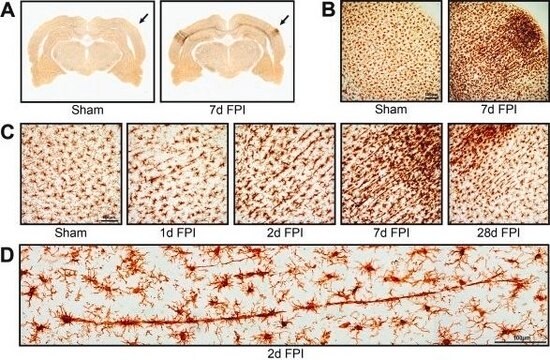一般說明
We are committed to bringing you greener alternative products, which adhere to one or more of The 12 Principles of Green Chemistry.This antibody is Preservative-free, produced without the harm or sacrifice of animals and exceptionally stable to allow for ambient shipping and storage if needed and thus aligns with "Waste Prevention", "Designing Safer Chemicals" and "Design for Energy Efficiency".
Click here for more information.
ZooMAb® antibodies represent an entirely new generation of recombinant monoclonal antibodies.Each ZooMAb® antibody is manufactured using our proprietary recombinant expression system, purified to homogeneity, and precisely dispensed to produce robust and highly reproducible lot-to-lot consistency. Only top-performing clones are released for use by researchers. Each antibody is validated for high specificity and affinity across multiple applications, including its most commonly used application. ZooMAb® antibodies are reliably available and ready to ship when you need them.
特異性
Clone 1E6 is a ZooMAb® Rabbit recombinant monoclonal antibody that specifically detects D-3-phosphoglycerate dehydrogenase (PHGDH) It targets and epitope within 19 amino acids from the internal region.
免疫原
KLH-conjugated linear peptide corresponding to 19 amino acids from the internal region of human D-3-phosphoglycerate dehydrogenase (PHGDH).
應用
Quality Control Testing
Evaluated by Western Blotting in A431 cell lysate.
Western Blotting Analysis: A 1:1,000 dilution of this antibody detected PHGDH in A431 cell lysate.
Tested applications
Western Blotting Analysis: A 1:1,000 dilution from a representative lot detected PHGDH in C6, NIH3T3, and HeLa cell lysates.
Immunohistochemistry (Paraffin) Analysis: A 1:100 dilution from a representative lot detected PHGDH in human salivary gland tissue sections.
Flow Cytometry Analysis: 1 μg from a representative lot detected PHGDH in one million C6 cells.
Affinity Binding Assay: A representative lot of this antibody bound PHGDH peptide with a KD of 3.8 x 10-7 in an affinity binding assay.
Immunocytochemistry Analysis: A 1:100 dilution from a representative lot detected PHGDH in A431, HeLa, and NIH3T3 cells.
Note: Actual optimal working dilutions must be determined by end user as specimens, and experimental conditions may vary with the end user
標靶描述
D-3-phosphoglycerate dehydrogenase (UniProt: O43175, also known as EC:1.1.1.95, 3-PGDH) is encoded by the PHGDH (also known as PGDH3) gene (Gene ID: 26227) in human. PDGH catalyzes the reversible oxidation of 3-phospho-D-glycerate (PGA) to 3-phosphonooxypyruvate (PHP), the first step of the phosphorylated L-serine biosynthesis pathway. In this reaction there is a concomitant reduction of NAD+ to NADH and to complete the pathway. In this pathway, phosphoserine amino transferase (PSAT) converts PHP to L-phosphoserine (PS) with the concomitant conversion of glutamate to -ketoglutarate ( KG), which is followed by the conversion of PS to L-serine with the loss of phosphate by phosphoserine phosphatase (PSP). PGDH also catalyzes the reversible oxidation of 2-hydroxyglutarate to 2-oxoglutarate and the reversible oxidation of (S)-malate to oxaloacetate. Based on their domain structure, three types of PGDH have been described. They catalyze the same reaction but exhibit certain mechanistic differences. Type 1 PGDH is composed of four domains, the substrate binding domain, the nucleotide binding domain, the allosteric substrate binding (ASB) domain, and the regulatory domain (ACT). Type 2 enzyme lacks the ASB domain and type 3 consists of only the substrate binding and nucleotide binding domains. The catalytic activity of PGDH is regulated by feedback inhibition by L-serine. PGDH is shown to be highly expressed in tumors as a result of amplification, transcription, or alterations in its degradation that leads to dysregulation of serine biosynthesis to nourish tumors. This ZooMAb® recombinant monoclonal antibody, generated by our propriety technology, offers significantly enhanced specificity, affinity, reproducibility, and stability over conventional monoclonals. (Ref.: Zhao, X., et al. (2020). Int. J. Biol. Sci. 16(9); 1495-1506; Grant, GA. (2018). Front. Mol. Biosci. 5; 110).
外觀
Purified recombinant rabbit monoclonal antibody IgG, lyophilized in PBS, 5% Trehalose, normal appearance a coarse or translucent resin. The PBS/trehalose components in the ZooMAb formulation can have the appearance of a semi-solid (bead like gel) after lyophilization. This is a normal phenomenon. Please follow the recommended reconstitution procedure in the data sheet to dissolve the semi-solid, bead-like, gel-appearing material. The resulting antibody solution is completely stable and functional as proven by full functional testing. Contains no biocide or preservatives, such as azide, or any animal by-products. Larger pack sizes provided as multiples of 25 μL.
重構
30 μg/mL after reconstitution at 25 μL per vial. Please refer to guidance on suggested starting dilutions and/or titers per application and sample type.
儲存和穩定性
Recommend storage of lyophilized product at 2-8°C; Before reconstitution, micro-centrifuge vials briefly to spin down material to bottom of the vial; Reconstitute each vial by adding 25 μL of filtered lab grade water or PBS; Reconstituted antibodies can be stored at 2-8°C, or -20°C for long term storage. Avoid repeated freeze-thaws.
法律資訊
ZooMAb is a registered trademark of Merck KGaA, Darmstadt, Germany
免責聲明
Unless otherwise stated in our catalog or other company documentation accompanying the product(s), our products are intended for research use only and are not to be used for any other purpose, which includes but is not limited to, unauthorized commercial uses, in vitro diagnostic uses, ex vivo or in vivo therapeutic uses or any type of consumption or application to humans or animals.





